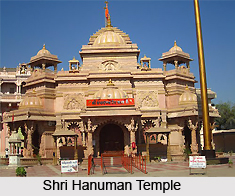 Shri Hanuman Temple, the much venerated pilgrimage centre is located in the village of Sarangpur in the Ahmedabad district in the Indian state of Gujarat. It is under the Vadtal Gadi of the Swaminarayan Sampraday. Lord Hanuman, the presiding deity of the temple is revered in the form of Kastbhanjan i.e. remover of sorrows. Sarangpur also known as Salangpur houses the only Swaminarayan temple enshrining Hanuman as its chief deity. The other Swaminarayan temples have a human form as its central deity with the idol of Hanuman and Lord Ganesha installed at the entrance of the shrine.
Shri Hanuman Temple, the much venerated pilgrimage centre is located in the village of Sarangpur in the Ahmedabad district in the Indian state of Gujarat. It is under the Vadtal Gadi of the Swaminarayan Sampraday. Lord Hanuman, the presiding deity of the temple is revered in the form of Kastbhanjan i.e. remover of sorrows. Sarangpur also known as Salangpur houses the only Swaminarayan temple enshrining Hanuman as its chief deity. The other Swaminarayan temples have a human form as its central deity with the idol of Hanuman and Lord Ganesha installed at the entrance of the shrine.
History of Shri Hanuman Temple
According to historical records Sadguru Gopalanand Swami installed the idol of Lord Hanuman in the temple. As per the records of author Raymond Williams, Sadguru Gopalanand Swami while installing the idol touched it with a rod that stirred life into it and made it move. The incident developed into a famous story and became the driving force behind the initiation of the healing ritual conducted in this temple.
Rituals of Shri Hanuman Temple
Lord Hanuman, the presiding deity of the temple is said to have a powerful influence over the devotees visiting the temple. The idol of the Lord is a stout figure having a handlebar moustache. He, standing in the midst of sculpted foliage bearing fruit is seen killing a female demon under his foot. Few monkeys are seen attending him. As per the local belief the powerful sway of the Lord helps in eliminating evil spirits. Devotees suffering from mental illnesses or some other disorder throng the temple premises to offer worship at they feet of the Lord and receive his blessings. The sick people are touched by the rod that was used by Sadguru Gopalanand Swami at the installation ceremony. The rod is now coated with silver. Following this, the affected person is asked to circumambulate the shrine and repeat the activity several times. Devotees are also instructed to chant the Swaminarayan Mahamantra while going around the temple.
A Brahmin householder has been appointed by the temple administration to accomplish the daily religious rituals of the temple. Besides the ailing patients several other devotees also visit the temple premises especially on Saturdays.





















